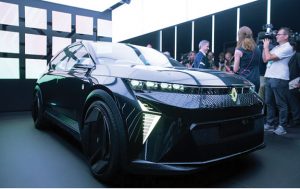Bloomberg
Renault SA is developing a family-sized passenger car that will run on electricity for short drives and hydrogen for longer trips as part of the company’s push into fuel-cell technology.
Dubbed Scenic Vision, the vehicle will have a carbon footprint that’s 75% lower than a conventional electric vehicle because it uses mostly recycled materials, a smaller battery and renewable energy sources to produce hydrogen, Renault said. The company plans to put the hybrid powertrain into vehicles from around 2030.
Chief Executive Officer Luca de Meo is rolling out more battery-powered models and aims to catch up with rivals in popular sport utility vehicle segment. He pledged a fresh lineup as part of a turnaround made more challenging by Renault’s costly pullout from Russia.
Still, the hydrogen push makes Renault an outlier among carmakers as the technology is still hampered by high costs and a lack of fuelling infrastructure. Across all automakers, hydrogen-powered vehicles are forecast to account for just 0.1% of global production by 2029, according to research from climate think tank InfluenceMap.
Renault is developing a family-sized passenger car that will run on electricity for short drives and hydrogen for longer trips as part of the company’s push into fuel-cell technology.
Toyota Motor Corp. remains the biggest proponent of hydrogen, which only emits water vapor, though the world’s biggest carmaker has changed tack with plans to add battery-electric models to keep pace with the rest of the industry. BMW AG has said the technology could become an alternative for larger vehicles.
Renault said about 70% of the Scenic Vision’s materials will be recycled, including a floor made from old plastic pipes and milk containers and a fuel cell membrane using platinum from discarded catalytic converters. The car’s exterior design will mimic an all-electric model scheduled to hit the market in 2024.
 The Gulf Time Newspaper One of the finest business newspapers in the UAE brought to you by our professional writers and editors.
The Gulf Time Newspaper One of the finest business newspapers in the UAE brought to you by our professional writers and editors.
